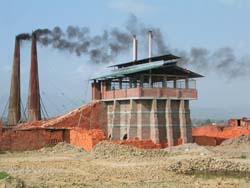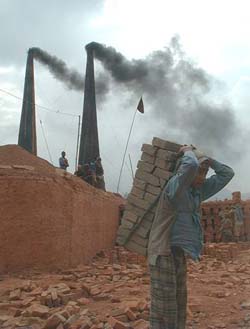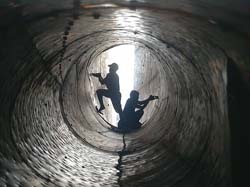|
Overview of Brick Industry in Kathmandu Valley, Nepal Nepal ranks as one of the most picturesque countries in the world, free from the vagaries of modern days technological developments. However with the penchant to keep pace along with the developed world, a pall of crisis is slowly and steadily looming large in the form of a highly polluting atmosphere. Apart from
vehicular pollution, numerous brick kilns dotting the landscape are major sources of obnoxious emissions. Being well aware of the future consequences, Swiss Agency for Development and Cooperation along with SKAT Consulting and Development Alternatives with active support from His Majesty's Government of Nepal is reintroducing a "cleaner and greener" brick production technology – the "Vertical Shaft Brick Kiln". Before
digging its roots in Nepal, numerous refinement and upgradation
generated in India perfected a scaleable model, ready to be
replicated anywhere in the world. In comparison with conventional
brick producing means this technology boasts of lower emission
standards, reduced energy consumption and economically viable means
of brick production, besides creating a socially equitable status
amongst the brick community. Historical Background Bricks are still and will continue to be the preferred walling material due to their abundan availability and pleasing nature widespread use of fired clay is also dependent on the availability of clay deposits for brick making found on agricultural land situated in valley floors and estuaries. Availability of water and market vicinity augment the operation of large number of brick kilns in the Kathmandu valley.
Various types of brick making technologies are practiced in the Kathmandu valley. These vary from simple intermittent type manual operations to continuous type and semi-mechanized ones. The simplest technology was introduced in Nepal in the early 1950’s and slowly replaced the traditional clamp kilns. An attempt to modernize the brick technology was made by the Nepal Government with technical and financial assistance of the People’s Republic of China in 1970 by introducing the Hoffman kiln technology. However, due to high initial investment cost and requirement of trained staff, this technology did not become popular in the private sector. After successful adaptation of Vertical Shaft Brick Kiln technology in China, it was introduced into Nepal in 1991 under a GATE – GTZ programme together with Ceramics Promotion Project. The energy saving potential was clearly demonstrated having an energy consumption of 1 MJ/Kg of fired brick. Thereafter another two shaft unit was set up in the Terai region. These shut down for lack of technical support.
The brick sector in Kathmandu valley, whose functioning and growth is directly linked to construction activity, is presently in the eye of a storm. Negative rate of growth in construction activity in past few years has resulted in a proliferation of brick kilns, which have reappeared in the Valley with spectacular speed raising serious concerns about the deteriorating air quality. It has been reported that brick kilns, producing in excess of 350 million bricks are the major single source of SO2 and SPM in the environment of Kathmandu valley; contributing over 60 percent of the emissions. The solutions to this problem must take into account the following competing factors that are at work.
The demand for burnt bricks continues to grow fuelled by an increased demand for housing in the Kathmandu valley. The customers have preference for burnt brick as the primary walling material; even though alternatives such as concrete blocks are increasingly being used for boundary and partition walls
The increase in supply of burnt bricks is ensured by willing entrepreneurs who jump at any opportunity for making quick profits. The entry barrier for new opportunistic traders is low.
The government of Nepal is aware of the serious environmental problems created by the brick kilns. The efforts are intensified by environmental watchdog organizations and activists, who are going hands with communities to limit the growth of kilns and force them to "clean up" or "close down". The government has set into motion the task of setting environmental performance standards for kilns but enforcement, even of existing legislation, continues to be weak.
The search for appropriate technology solutions as an alternate to conventional Bulls Trench Kiln and open clamps led to the VSBK technology as a possible alternative. Vertical Shaft Brick Kiln (VSBK) is an energy efficient and environment friendly technology for fired clay brick production. It essentially consists of one or more rectangular, vertical shafts within the kiln structure. The shafts are 1 to 1.25 metres wide with nominal lengths varying between 1 to 2 m. Shaft heights can be varied to hold from 8 to 13 batches depending on green brick crushing strength. The inside surface is a brick wall lined with refractory bricks to minimize heat loss. Gap between the shaft and outer kiln wall is filled with insulating materials – burnt bricks and burnt coal ash etc. Provisions for peep holes for thermocouple probes are provided along the shaft height to monitor the position of fire as well as temperature profile of the kiln. Rectangular rows of dried green bricks and crushed fuel (coal) are carefully stacked into batches, and are continuously loaded from the top of the shaft. Each batch typically contains four layers of bricks set in a predetermined pattern The heating cycle for the green bricks is raw material specific (pre-heating, vitrification and cooling down) and is normally completed within 24-30 hours. A batch of bricks is loaded and unloaded every 2-3 hours; requiring round the clock operations and supervision. Unique features of VSBK are: Ř High energy efficiencyŘ Environment friendly operationsŘ Economically viable Ř Uniform quality of production
To cater to the ever increasing demand of bricks, around 250-300 moveable chimney and clamp kilns dot the Kathmandu valley,
creating a single most, major source of environmental pollution in the valley. The resultant emission of harmful gases like SO2, CO2, CO, NOX and respiratory particulate matter severally affect the surrounding habitat and also contribute to global warming. It also has detrimental effects on the flora and fauna affecting the means of nurturing sustainable livelihoods. Smoke emanated during the firing process has made old handicrafts, exquisite temples and other archeological treasures dusty and dull. The only silver lining in this problematic cloud is the awareness created in the minds of people searching for a better and cleaner environment. Hsis Majesty’s Government of Nepal has passed orders to close all the movable chimney BTK’s and has advised the brick owners to switch over into new technologies fulfilling all the energy and environmental regulations. Kathmandu valley is a bowl shaped area surrounded by high mountains. The only possible way to save the habitat is either dissipate the obvious smoke beyond the valley; which is "mission impossible" due to the more than 1000m high mountains or adopt technologies which reduce the SPM content considerably creating a "Green Valley". To fulfill the second criteria various options like VSBK, gas and electric fired tunnel kilns, roller hearth kilns are available. However judging from the investment and case of operation, VSBK is the most appropriate brick firing technology for Kathmandu valley –Nepal. The most important factors which merit credit over all the modern available technologies are:
VSBK gives unmatched flexibility of operation, good quality and substantial saving in energy consumption. It economizes on fuel costs achieving savings of between 30-50 percent when compared with other brick firing technologies such as clamp, moveable chimney or fixed chimney BTK’s.
Brick production using VSBK technology is a profitable business due to substantial fuel savings. Initial investment although is high compared to fixed chimney BTK of similar capacity, but it can be recovered in a single season operation through fuel savings only. Operating capital requirement is very low and returns are within 2 days compared to 24 days in BTK’s.
Installation and operation of VSBK requires very little land. Construction of multiple shaft production units further enhances the ratio of land use to production output. As VSBK firing only requires coal or lignite, deforestation of rural areas can be controlled. Additionally benchmark operation of VSBK lead to highly reduced emissions compared to clamps or moveable / fixed chimney BTK’s.
In the Kathmandu valley, higher fuel savings are likely due to poor regard to quality. Significantly the bricks in Kathmandu are only 55 mm thick and through use of internal fuel, further savings may also be possible using VSBK technology. The specific consumption of bricks fired using the VSBK technology is likely to be 1 MJ/Kg of brick or less.
The VSBK Nepal project has in the short space of five months, been successful in setting up two pilot kilns. Preliminary energy and ecnvironmental monitoring exercises indicate saving of approximately 30% energy and an 80% reduction in emission of suspended particulate matter. Plans are now being drawn up to further customise the VSBK technology package to suit local conditions and refine the strategy for more widespread dissemination. With the advent of the VSBK Nepal project, we sincerely hope to see a "Green and Clean" Kathmandu in the next couple of years; helping our future to nourish and grow in a healthy environment. q |


